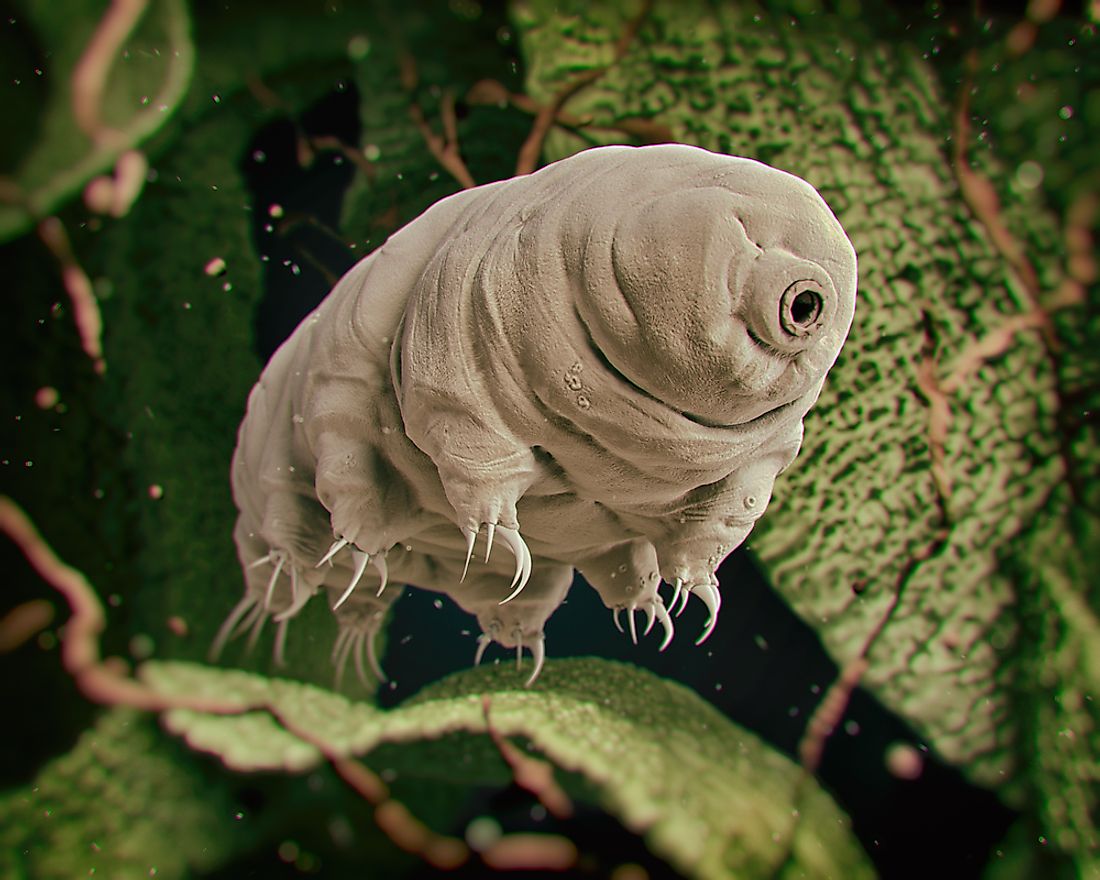What is a Water Bear?

Water bears, also called tardigrades, are micro animals living in water, and they belong to the division of small invertebrates. These animals can be found in mud volcanoes, the deep sea, and mountaintops in Antarctic and rainforests climates. They are among the most resilient animals as they can survive extreme conditions that other life forms might not withstand.
5. Physical Description
Water bears are animals with symmetrical bodies measuring between 0.2 to 1.2 millimeters. A large percentage of water bears are clear or whitish in color, while some of those living on the land are orange, greenish black, red, yellow, or green. The body of a water bear does not have distinct segments, but they include four trunks and head, with each segment in the trunk having a pair of legs. The legs of freshwater and terrestrial species have fewer segments than the ones for the other species. The legs for a significant portion of marine water bears are telescoping, and they can withdraw them from inside their bodies. In addition, the legs can have four toe-like structures with different numbers of claws depending on the species. The toes of some species are similar to those of a gecko in the sense that they have rod-shaped discs and they are sticky. Furthermore, they shed their cuticles, and special glands that they possess are responsible for the production of their mouthparts, claws, and toes. The mouth of a water bear has bristle-like jaws that it uses for feeding by sucking fluids into the mouth after puncturing cells using the stylets. Water bears lack respiratory systems due to their small size and their moist habitat. Instead, they use their body walls for direct breathing. Since they depend on water for gas exchange to take place in their bodies, all the species of water bears are considered aquatic animals.
4. Diet
Water bears can be bacteriophages, carnivorous or phytophagous. The phytophagous water bears feed on fluid from lichens and algae moss for survival while others suck the fluids of the animal cells. Some carnivorous tardigrades are cannibals since they feed on other smaller species of water bears, and some of them entirely feed on live organisms, including the rotifers. The stylets in their mouths allow them to pierce the animal body walls or the plant cells easily. They ingest the internal contents of the items of their food by use of the sucking pharyngeal.
3. Behavior
Some species of water bears reproduce through pure asexual reproduction or pure sexual reproduction, while others can reproduce through either means. The movement of water bears involve swimming or walking with their legs, and they usually move to get food. They cannot migrate intentionally, but due to their small sizes and that of their eggs, they are regularly moved by other animals’ migration or the wind. In most cases, water bears do not communicate, but some of the marine water bears exhibit some behaviors of communication called cyclomorphosis. Particularly, the Halobiotus crispae, a particular species of water bears, exhibits this behavior by changing forms from winter to summer. Mostly, they are sexually inactive during winter because they are hibernating. Other water bears of this species usually gather during extreme conditions of winter so that they can protect themselves, and all of them become sexually mature at the same time at the start of summer.
2. Habitat
Tardigrades can dwell anywhere, but they prefer living in moist or wet environments. Most species of water bears dwell in semiaquatic terrestrial or freshwater environments, while others are the marine species. A large percentage of tardigrades' species live in milder environments including meadows, lakes, and ponds, while the other portion dwells in roofs and stalls. Mostly, they live on the moist pieces of moss or at the bottom of lakes in sediment. However, some species of water bears are found in hot springs, under solid layers of ice, and in the ocean sediments. Despite the fact that these animals live mostly in moist environments, they can remain active in an environment in which they can retain even a small amount of moisture. Surprisingly, water bears can live for over thirty years without food, and they can dry out to have less than 3% of water in their bodies. For dry environments, these animals also can stay in a dry state for approximately ten years without undergoing complete dehydration. Some water bears can withstand a temperature close to absolute zero, while others can survive at a temperature as high as 420K for some time.
1. Extreme Survivalists
Water bears can survive in environments with extreme conditions in which other animals would perish. Some of the conditions that individual species of water bears can survive are the impacts of large meteorites, gamma-ray bursts, and supernovae. In environments with extremely high or low pressure, tardigrades are also capable of survival. On top of that, they can even withstand dangerous radiations that would kill other animals. Tardigrades have a vital adaptation to survive in the environment with toxins-they undergo a process called chemobiosis. It is believed that this process is a cryptobiotic response towards a surrounding with high-level poisonous substances. Lastly, but not the least, water bears are said to be the first animals to be known to survive in space. According to scientists, the cosmic radiation does not have a significant effect on the life of these animals, and thus they are the most appropriate animals crucial for space research. Due to their ability to survive in all these extreme environments, water bears add to the list of the few groups of animals that have survived the five mass extinctions of the Earth.











